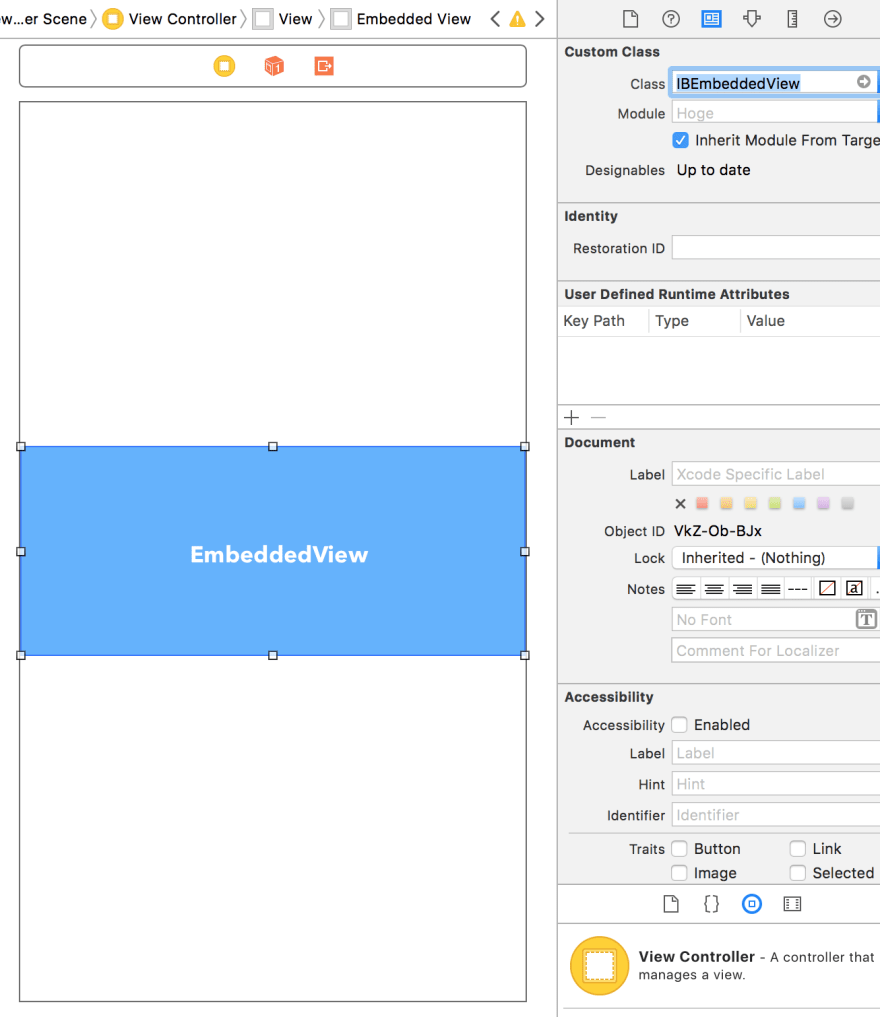This is a collection of Swift's convenience extensions I always use. Protocols and operators are also included.
All of the extensions are in the following repository.
https://github.com/tattn/SwiftExtensions
- The version of Swift is 4.0.
- This is a translated version of the article I wrote in Japanese here.
Get a class name
public protocol ClassNameProtocol {
static var className: String { get }
var className: String { get }
}
public extension ClassNameProtocol {
public static var className: String {
return String(describing: self)
}
public var className: String {
return type(of: self).className
}
}
extension NSObject: ClassNameProtocol {}
UIView.className //=> "UIView"
UILabel().className //=> "UILabel"
Register / Dequeue XIB
UITableView
public extension UITableView {
public func register<T: UITableViewCell>(cellType: T.Type, bundle: Bundle? = nil) {
let className = cellType.className
let nib = UINib(nibName: className, bundle: bundle)
register(nib, forCellReuseIdentifier: className)
}
public func register<T: UITableViewCell>(cellTypes: [T.Type], bundle: Bundle? = nil) {
cellTypes.forEach { register(cellType: $0, bundle: bundle) }
}
public func dequeueReusableCell<T: UITableViewCell>(with type: T.Type, for indexPath: IndexPath) -> T {
return self.dequeueReusableCell(withIdentifier: type.className, for: indexPath) as! T
}
}
tableView.register(cellType: MyCell.self)
tableView.register(cellTypes: [MyCell1.self, MyCell2.self])
let cell = tableView.dequeueReusableCell(with: MyCell.self, for: indexPath)
UICollectionView
public extension UICollectionView {
public func register<T: UICollectionViewCell>(cellType: T.Type, bundle: Bundle? = nil) {
let className = cellType.className
let nib = UINib(nibName: className, bundle: bundle)
register(nib, forCellWithReuseIdentifier: className)
}
public func register<T: UICollectionViewCell>(cellTypes: [T.Type], bundle: Bundle? = nil) {
cellTypes.forEach { register(cellType: $0, bundle: bundle) }
}
public func register<T: UICollectionReusableView>(reusableViewType: T.Type,
ofKind kind: String = UICollectionElementKindSectionHeader,
bundle: Bundle? = nil) {
let className = reusableViewType.className
let nib = UINib(nibName: className, bundle: bundle)
register(nib, forSupplementaryViewOfKind: kind, withReuseIdentifier: className)
}
public func register<T: UICollectionReusableView>(reusableViewTypes: [T.Type],
ofKind kind: String = UICollectionElementKindSectionHeader,
bundle: Bundle? = nil) {
reusableViewTypes.forEach { register(reusableViewType: $0, ofKind: kind, bundle: bundle) }
}
public func dequeueReusableCell<T: UICollectionViewCell>(with type: T.Type,
for indexPath: IndexPath) -> T {
return dequeueReusableCell(withReuseIdentifier: type.className, for: indexPath) as! T
}
public func dequeueReusableView<T: UICollectionReusableView>(with type: T.Type,
for indexPath: IndexPath,
ofKind kind: String = UICollectionElementKindSectionHeader) -> T {
return dequeueReusableSupplementaryView(ofKind: kind, withReuseIdentifier: type.className, for: indexPath) as! T
}
}
collectionView.register(cellType: MyCell.self)
collectionView.register(cellTypes: [MyCell1.self, MyCell2.self])
let cell = collectionView.dequeueReusableCell(with: MyCell.self, for: indexPath)
collectionView.register(reusableViewType: MyReusableView.self)
collectionView.register(reusableViewTypes: [MyReusableView1.self, MyReusableView2.self])
let view = collectionView.dequeueReusableView(with: MyReusableView.self, for: indexPath)
Instantiate a viewController in a storyboard
public enum StoryboardInstantiateType {
case initial
case identifier(String)
}
public protocol StoryboardInstantiatable {
static var storyboardName: String { get }
static var storyboardBundle: Bundle { get }
static var instantiateType: StoryboardInstantiateType { get }
}
public extension StoryboardInstantiatable where Self: NSObject {
public static var storyboardName: String {
return className
}
public static var storyboardBundle: Bundle {
return Bundle(for: self)
}
private static var storyboard: UIStoryboard {
return UIStoryboard(name: storyboardName, bundle: storyboardBundle)
}
public static var instantiateType: StoryboardInstantiateType {
return .identifier(className)
}
}
public extension StoryboardInstantiatable where Self: UIViewController {
public static func instantiate() -> Self {
switch instantiateType {
case .initial:
return storyboard.instantiateInitialViewController() as! Self
case .identifier(let identifier):
return storyboard.instantiateViewController(withIdentifier: identifier) as! Self
}
}
}
// Class name and Storyboard name, same as Storyboard ID
final class ViewController: UIViewController, StoryboardInstantiatable {
}
ViewController.instantiate()
// Initial view controller & class name and Storyboard name are the same
final class InitialViewController: UIViewController, StoryboardInstantiatable {
static var instantiateType: StoryboardInstantiateType {
return .initial
}
}
InitialViewController.instantiate()
Instantiate a view in XIB
public protocol NibInstantiatable {
static var nibName: String { get }
static var nibBundle: Bundle { get }
static var nibOwner: Any? { get }
static var nibOptions: [AnyHashable: Any]? { get }
static var instantiateIndex: Int { get }
}
public extension NibInstantiatable where Self: NSObject {
public static var nibName: String { return className }
public static var nibBundle: Bundle { return Bundle(for: self) }
public static var nibOwner: Any? { return self }
public static var nibOptions: [AnyHashable: Any]? { return nil }
public static var instantiateIndex: Int { return 0 }
}
public extension NibInstantiatable where Self: UIView {
public static func instantiate() -> Self {
let nib = UINib(nibName: nibName, bundle: nibBundle)
return nib.instantiate(withOwner: nibOwner, options: nibOptions)[instantiateIndex] as! Self
}
}
// XIB name and class name are the same & 0th View
final class View: UIView, NibInstantiatable {
}
View.instantiate()
// XIB name and class name are different & & 2nd View
final class View2: UIView, NibInstantiatable {
static var nibName: String { return "Foo" } // Foo.xib
static var instantiateIndex: Int { return 2 }
}
View2.instantiate()
Put a custom view created by Xib in Interface Builder
public protocol EmbeddedNibInstantiatable {
associatedtype Embedded: NibInstantiatable
}
public extension EmbeddedNibInstantiatable where Self: UIView, Embedded: UIView {
public var embedded: Embedded { return subviews[0] as! Embedded }
public func configureEmbededView() {
let view = Embedded.instantiate()
insertSubview(view, at: 0)
view.fillSuperview() // described later
}
}
final class EmbeddedView: UIView, NibInstantiatable {
}
@IBDesignable
final class IBEmbeddedView: UIView, EmbeddedNibInstantiatable {
typealias Embedded = EmbeddedView
#if TARGET_INTERFACE_BUILDER
override func prepareForInterfaceBuilder() {
super.prepareForInterfaceBuilder()
configureEmbededView()
}
#endif
override func awakeFromNib() {
super.awakeFromNib()
configureEmbededView()
}
}
Make a view the same size as the superview
public extension UIView {
public func fillSuperview() {
guard let superview = self.superview else { return }
translatesAutoresizingMaskIntoConstraints = superview.translatesAutoresizingMaskIntoConstraints
if translatesAutoresizingMaskIntoConstraints {
autoresizingMask = [.flexibleWidth, .flexibleHeight]
frame = superview.bounds
} else {
topAnchor.constraint(equalTo: superview.topAnchor).isActive = true
bottomAnchor.constraint(equalTo: superview.bottomAnchor).isActive = true
leftAnchor.constraint(equalTo: superview.leftAnchor).isActive = true
rightAnchor.constraint(equalTo: superview.rightAnchor).isActive = true
}
}
}
superView.addSubview(view)
view.fillSuperview()
Get the top most UIViewController / UINavigationController
public extension UIApplication {
public var topViewController: UIViewController? {
guard var topViewController = UIApplication.shared.keyWindow?.rootViewController else { return nil }
while let presentedViewController = topViewController.presentedViewController {
topViewController = presentedViewController
}
return topViewController
}
public var topNavigationController: UINavigationController? {
return topViewController as? UINavigationController
}
}
UIApplication.shared.topViewController
Get a view controller which has the view
public extension UIView {
public var viewController: UIViewController? {
var parent: UIResponder? = self
while parent != nil {
parent = parent?.next
if let viewController = parent as? UIViewController {
return viewController
}
}
return nil
}
}
view.viewController
Create a UIColor by hexadecimal
public extension UIColor {
public convenience init(hex: Int, alpha: CGFloat = 1.0) {
let r = CGFloat((hex & 0xFF0000) >> 16) / 255.0
let g = CGFloat((hex & 0x00FF00) >> 8) / 255.0
let b = CGFloat(hex & 0x0000FF) / 255.0
self.init(red: r, green: g, blue: b, alpha: alpha)
}
}
let color = UIColor(hex: 0xAABBCC)
Remove elements by the instances in an array
public extension Array where Element: Equatable {
@discardableResult
public mutating func remove(element: Element) -> Index? {
guard let index = index(of: element) else { return nil }
remove(at: index)
return index
}
@discardableResult
public mutating func remove(elements: [Element]) -> [Index] {
return elements.flatMap { remove(element: $0) }
}
}
let array = ["foo", "bar"]
array.remove(element: "foo")
array //=> ["bar"]
Remove the same value from the array
public extension Array where Element: Hashable {
public mutating func unify() {
self = unified()
}
}
public extension Collection where Element: Hashable {
public func unified() -> [Element] {
return Array(Set(self))
}
}
let array = [1, 2, 3, 3, 2, 1, 4]
array.unify() // [1, 2, 3, 4]
Get an element in safety.
public extension Collection {
public subscript(safe index: Index) -> Element? {
return startIndex <= index && index < endIndex ? self[index] : nil
}
}
let array = [0, 1, 2]
if let item = array[safe: 5] {
print("unreachable")
}
Get substrings with various ranges
public extension String {
subscript (bounds: CountableClosedRange<Int>) -> String {
let start = index(startIndex, offsetBy: bounds.lowerBound)
let end = index(startIndex, offsetBy: bounds.upperBound)
return String(self[start...end])
}
subscript (bounds: CountableRange<Int>) -> String {
let start = index(startIndex, offsetBy: bounds.lowerBound)
let end = index(startIndex, offsetBy: bounds.upperBound)
return String(self[start..<end])
}
subscript (bounds: PartialRangeUpTo<Int>) -> String {
let end = index(startIndex, offsetBy: bounds.upperBound)
return String(self[startIndex..<end])
}
subscript (bounds: PartialRangeThrough<Int>) -> String {
let end = index(startIndex, offsetBy: bounds.upperBound)
return String(self[startIndex...end])
}
subscript (bounds: CountablePartialRangeFrom<Int>) -> String {
let start = index(startIndex, offsetBy: bounds.lowerBound)
return String(self[start..<endIndex])
}
}
let string = "0123456789"
string[0...5] //=> "012345"
string[1...3] //=> "123"
string[3..<7] //=> "3456"
string[...4] //=> "01234
string[..<4] //=> "0123"
string[4...] //=> "456789"
Create URL from a string / Create URL from a string literal
public extension String {
public var url: URL? {
return URL(string: self)
}
}
extension URL: ExpressibleByStringLiteral {
public init(stringLiteral value: String) {
guard let url = URL(string: value) else {
fatalError("\(value) is an invalid url")
}
self = url
}
public init(extendedGraphemeClusterLiteral value: String) {
self.init(stringLiteral: value)
}
public init(unicodeScalarLiteral value: String) {
self.init(stringLiteral: value)
}
}
if let url = "https://example.com".url {
}
let url: URL = "https://example.com"
Use Kotlin-like scope function
public protocol Appliable {}
public extension Appliable {
@discardableResult
public func apply(closure: (Self) -> Void) -> Self {
closure(self)
return self
}
}
public protocol Runnable {}
public extension Runnable {
@discardableResult
public func run<T>(closure: (Self) -> T) -> T {
return closure(self)
}
}
extension NSObject: Appliable {}
extension NSObject: Runnable {}
let view = UIView().apply {
$0.backgroundColor = .red
$0.frame = .init(x: 0, y: 0, width: 200, height: 200)
}
Throw an error by ??? if the value is nil
infix operator ???
public func ???<T>(lhs: T?,
error: @autoclosure () -> Error) throws -> T {
guard let value = lhs else { throw error() }
return value
}
let value: String? = nil
struct OptionalError: Error {}
do {
let v = try value ??? OptionalError()
print(v) // unreachable
} catch {
print(error) //=> OptionalError
}
Throw an error if there is no key when getting the value from a dictionary
public struct DictionaryTryValueError: Error {
public init() {}
}
public extension Dictionary {
func tryValue(forKey key: Key, error: Error = DictionaryTryValueError()) throws -> Value {
guard let value = self[key] else { throw error }
return value
}
}
var dictionary: [String: Int] = [:]
do {
let value = try dictionary.tryValue(forKey: "foo")
print(value) // unreachable
} catch {
print(error) //=> DictionaryTryValueError
}
Create properties and methods accessible with .ex
public struct TargetedExtension<Base> {
let base: Base
init (_ base: Base) {
self.base = base
}
}
public protocol TargetedExtensionCompatible {
associatedtype Compatible
static var ex: TargetedExtension<Compatible>.Type { get }
var ex: TargetedExtension<Compatible> { get }
}
public extension TargetedExtensionCompatible {
public static var ex: TargetedExtension<Self>.Type {
return TargetedExtension<Self>.self
}
public var ex: TargetedExtension<Self> {
return TargetedExtension(self)
}
}
extension UIView: TargetedExtensionCompatible {}
private extension TargetedExtension where Base: UIView {
func foo() {}
}
UIView().ex.foo()








Top comments (10)
I think you missed something here
It should be
Thanks so much for this - several of these are now in my default toolbox. :)
you so cool man, thx!!!
Hello!
Array(Set(array))
is faster then
func unified() -> [Element] { ... }
Check it please.
You're right, I'll update it. Thanks!
wow, really cool bro 👍🏻
Thanks man! =)
Awesome collection
Thanks!
Some comments may only be visible to logged-in visitors. Sign in to view all comments.